Assessment of the Agroecological Transition of Farms in Central Tunisia Using the TAPE Framework
Abstract
1. Introduction
2. Materials and Methods
2.1. Study Area and Household Selection
2.2. Data Collection and Analysis
- Step 0: Contextualization of the Study Area: This preliminary step involved a desk review to understand the socio-economic (e.g., household income levels, employment access and education levels), demographic (e.g., population growth and gender dynamics), environmental (e.g., climate conditions, biodiversity, and water availability), and institutional (e.g., Government policies and agricultural extension services) contexts of the Sbikha delegation. The review included sources such as studies, administrative reports, and national statistics produced by the Ministry of Agriculture and affiliated institutions.
- Step 1: Characterizing Agroecological Transitions (CAET): Step 1 aimed to assess the extent of agroecology adoption among farming households. Data were collected through structured surveys conducted with 50 selected farmers, supplemented by observations from local agricultural administration officials. The CAET framework is based on 37 indicators grouped under the 10 elements of agroecology defined by the FAO. In our study, we worked with 35 indicators (Table A1). The FAO-TAPE framework explicitly encourages contextual adaptations to ensure the assessment remains relevant to local realities, without compromising its methodological robustness. In the study region, smallholder farmers have limited access to formal credit systems and often rely on informal financial networks. Consequently, quantifying indicators such as farmers’ indebtedness and income from diversified activities proved impractical, as respondents either lacked financial records or were reluctant to disclose sensitive personal information.
- Step 1 bis: Typology of Agricultural Systems: This step is optional in the TAPE framework. Indeed, to further refine the analysis, Step 1 bis classified farms based on criteria such as diversity, production orientation, and CAET scores. The methods used to develop these typologies can vary, ranging from participatory approaches and statistical techniques to expert-driven classifications [31,32]. In our study, we employed an expert-driven typology approach, leveraging the knowledge of the local agricultural administration officials (CRDA Kairouan and CTV Sbikha). This typology was developed according to the main orientation of the production systems of the 50 studied farms (cereals, vegetable crops, olive trees, fruit trees). Particularly, 15 farms are specialized in cereals and vegetable crops, 18 farms are specialized in olive trees and vegetable crops, and 17 farms are specialized in fruit trees.
- Step 2: Multidimensional Performance Assessment: This step evaluated agroecological performance across three key dimensions: economic (e.g., farm income and market access), environmental (e.g., biodiversity and water use efficiency), and social (e.g., gender inclusion and food security). These dimensions are aligned with national policymakers’ strategic priorities aimed at promoting the sustainability and resilience of agricultural systems. Specific criteria are defined for each dimension, followed by the identification of indicators. A concise list of 10 core criteria has been established to guide this evaluation (Table A2). Data collection combines interviews, direct field observations, and structured surveys with farms and local agricultural administration officials.
- Step 3: Participatory Interpretation of Results: In the final step, findings from Steps 1 and 2 were validated through participatory discussions with farmers and stakeholders (e.g., CRDA Kairouan and CTV Sbikha) during farms visits. This process ensured that the data accurately reflected local realities and helped generate actionable recommendations for improving agroecological practices. The participatory approach also played a role in policy guidance and capacity-building efforts.
2.3. Statistical Analysis
3. Results and Discussion
3.1. Contextualization of the Sbikha Delegation
3.2. Characterization of the Agroecological Transition (CAET)
3.3. Correlations Between the Elements of Agroecology and the Overall Agroecological Transition (CAET)
3.4. Typology of Households
- -
- Type 1. Farms Specializing in Cereal and Vegetable Crops (CVC): This type represents 30% of the farms studied, with a primary focus on cultivating cereals (such as barley, durum wheat, and soft wheat) and vegetables (such as beans, tomatoes, onions, peppers, and peas). The average farm size is 2.6 ha, and most of these farms also engage in sheep and goat farming, with an average herd size of seven animals. The average number of family members working on the farm is three. This type achieved a very low CAET score of only 33%, indicating that these farms do not meet agroecological criteria (CAET < 40).
- -
- Type 2. Farms Specializing in Olive trees and Vegetable Crops (OVC): This second type represents 37% of the farms studied, with a primary focus on olive trees cultivation and vegetable crops such as beans, tomatoes, onions, peppers, watermelon, and melon. The average farm size for this type is estimated at 5 ha, with the integration of cattle farming (an average of 2 herds) and sheep farming (an average of 10 sheep). The average family labor force is estimated at four members. This type reaches a moderately low CAET score of 41%, and farms are also considered non-agroecological (CAET between 40 and 50).
- -
- Type 3. Farms Specializing in Fruit Tree (FT): This type represents 33% of the farms studied, specializing in fruit tree cultivation, including peach, plum, and apricot trees, with an average farm size of 8 ha. Some of these farms also grow vegetable crops through intercropping, such as beans, tomatoes, chili peppers, and peas. Additionally, the majority of these farms practice sheep and dairy cattle farming. This type achieves an average CAET score of 51%, and farms are in incipient agroecological transition (CAET between 50 and 60).
3.5. Core Criteria of Performance: The Multidimensional Performance of Agroecology
3.5.1. Social Dimension
3.5.2. Economic Dimension
3.5.3. Environmental Dimension
4. Conclusions
Supplementary Materials
Author Contributions
Funding
Institutional Review Board Statement
Informed Consent Statement
Data Availability Statement
Conflicts of Interest
Appendix A
| Elements | Indicators |
|---|---|
| 1. Diversity | 1.1. Crops |
| 1.2. Animals | |
| 1.3. Trees and other perennials | |
| 1.4. Diversity of activities, products, and services | |
| 2. Synergies | 2.1. Crop–livestock integration |
| 2.2. Soil–plant system management | |
| 2.3. Integration with trees | |
| 2.4. Connectivity between agroecosystem elements and the landscape | |
| 3. Efficiency | 3.1. Use of external inputs |
| 3.2. Soil fertility management | |
| 3.3. Pest and diseases management | |
| 3.4. Productivity and household needs | |
| 4. Recycling | 4.1. Recycling of biomass and nutrients |
| 4.2. Water saving | |
| 4.3. Seeds and breeds management | |
| 4.4. Renewable energy and production | |
| 5. Resilience | 5.1. Stability of income/production and capacity to recover from perturbations |
| 5.2. Mechanisms for reducing vulnerability | |
| 5.3. Environmental resilience and capacity to adapt to climate change | |
| 6. Culture and Food Tradition | 6.1. Appropriate diet and nutrition awareness |
| 6.2. Local or traditional identity and awareness | |
| 6.3. Use of local varieties/breeds and traditional knowledge in food preparation | |
| 7. Co-creation and Sharing of Knowledge | 7.1. Platforms for horizontal knowledge creation and transfer of good practices |
| 7.2. Access to agroecological knowledge and interest of producers in agroecology | |
| 7.3. Participation of producers in networks and grassroots organizations | |
| 8. Human and Social Values | 8.1. Women’s empowerment |
| 8.2. Labor (working conditions, social inequalities) | |
| 8.3. Youth empowerment and migration | |
| 8.4. Animal welfare | |
| 9. Circular and Solidarity Economy | 9.1. Products and services marketed locally |
| 9.2. Networks of producers, relationships with consumers, and role of intermediaries | |
| 9.3. Local food system | |
| 10. Responsible Governance | 10.1. Producers’ empowerment |
| 10.2. Producers’ organizations and associations | |
| 10.3. Producers participation in land and natural resources governance |
| Main Dimension | Core Criteria of Performance | Proposed Method of Assessment in Survey | SDG | SDG Indicators |
|---|---|---|---|---|
| Governance | 1. Secure land tenure | Include forms of land tenure, such as ownership, rental agreements (including specific timeframes), informal or unwritten arrangements, and the presence or utilization of pastoral systems. | 1 2 5 | 1.4.2 2.4.1 5.a.1 |
| Economy | 2. Productivity |
| 2 | 2.3.1 2.4.1 |
| 3. Income | Income = Products − inputs − operating expenses − depreciation + other income | 1 2 10 | 1.1.1, 1.2.1 and 1.2.2 2.3.2 2.4.1 10.2.1 | |
| 4. Added value | Added value = Gross value of agricultural production − (expenses for inputs + intermediates consumptions + depreciation) | 10 | 10.1.1 10.2.1 | |
| Health and nutrition | 5. Exposure to pesticides | Include quantity applied, treated area, toxicity levels, and availability of risk mitigation equipment and practices. | 3 | 3.9.1 3.9.2 3.9.3 |
| 6. Dietary diversity | Correspond to the Minimum Dietary Diversity for Women, based on consumption of 10 food groups in the past 24 h. | 2 | 2.1.1 2.1.2 2.2.1 2.2.2 2.4.1 | |
| Society and Culture | 7. Women’s empowerment | Abbreviated Women’s Empowerment in Agriculture Index (A-WEAI), developed to assess women’s roles in agricultural decision-making, access to resources, and their overall well-being within agricultural households. | 2 5 | 2.4.1 5.a.1 5.a.2 |
| 8. Youth employment opportunity | Access to jobs, training and or education; migration opportunities. | 8 | 8.6.1 | |
| Environment | 9. Agricultural biodiversity | Relative importance of crop varieties, animal breeds, tree species, and semi-natural environments within production units. | 2 15 | 2.4.1 2.5.1 |
| 10. Soil health | Adapted SOCLA (Latin American Scientific Society of Agroecology) rapid and farmer friendly agroecological method to assess soil health. | 2 15 | 2.4.1 15.3.1 |
| Core Criteria of Performance | Sustainability Levels |
|---|---|
| Secure land tenure | Green (desirable): Has a formal document with the name of the holder on it. |
| Yellow (acceptable): Has no document but has perception of secure land and has at least one right to sell/bequeath/inherit the land. | |
| Red (unsustainable): No document possessed. | |
| Productivity | Green (desirable): Productivity value per ha is ≥2/3 of the national average value of production per hectare/year. |
| Yellow (acceptable): Productivity value per ha is ≥1/3 and <2/3 of the national average value of production per hectare/year. | |
| Red (unsustainable): Productivity value per ha is <1/3 of the national average value of production per hectare/year. | |
| Revenue | Green (desirable): Perception that income is increasing and > average income in the region. |
| Yellow (acceptable): Perception that income is stable and = average income in the region. | |
| Red (unsustainable): Perception that income is decreasing or < average income in the region. | |
| Added Value | Green (desirable): Gross added value/family worker >1.2 × national agricultural GDP per agricultural worker. |
| Yellow (acceptable): Gross added value/family worker <1.2 × national agricultural GDP per agricultural worker. | |
| Red (unsustainable): Gross added value/family worker <0.8 × national agricultural GDP per agricultural worker. | |
| Exposure to Pesticides | Green (desirable): Quantity of organic pesticides used ≥ Quantity of synthetic pesticides used. |
| Yellow (acceptable): Quantity of synthetic pesticides used > quantity of organic pesticides used. | |
| Red (unsustainable): producers use chemical pesticides of any class and no organic pesticides and no other integrated techniques are used. | |
| Dietary Diversity | Green (desirable): Minimum Dietary Diversity for Women (MDD): score ≥ 7 |
| Yellow (acceptable): 5 ≥ MDD score < 7 | |
| Red (unsustainable): score < 5 | |
| Women’s Empowerment | Green (desirable): A-WEAI ≥ 80% |
| Yellow (acceptable): A-WEAI ≥ 60% and <80% | |
| Red (unsustainable): A-WEAI < 60% | |
| Youth Employment Opportunities | Green (desirable): Score ≥ 70% |
| Yellow (acceptable): Score ≥ 50% and <70% | |
| Red (unsustainable): Score < 50% | |
| Agricultural Biodiversity | Green (desirable): Average score is ≥70% |
| Yellow (acceptable): Average score is ≥50% and <70% | |
| Red (unsustainable): Average score is <50% | |
| Soil Health | Green (desirable): Average score is ≥3.5 |
| Yellow (acceptable): Average score is ≥2.5 and <3.5 | |
| Red (unsustainable): Average score is <2.5 |
References
- Amoak, D.; Luginaah, I.; McBean, G. Climate change, food security, and health: Harnessing agroecology to build climate-resilient communities. Sustainability 2002, 14, 13954. [Google Scholar] [CrossRef]
- Muchiutti, A.A.; Jacobo, E.; Quintana, R.; Attademo, A.M. Livestock production systems in wetlands of Argentina: Assessing transition toward sustainable agroecological systems. Agroecol. Sustain. Food Syst. 2024, 49, 91–123. [Google Scholar] [CrossRef]
- Mac Loughlin, T.M.; Peluso, M.L.; Marino, D.J. Multiple pesticides occurrence, fate, and environmental risk assessment in a small horticultural stream of Argentina. Sci. Total Environ. 2022, 802, 149893. [Google Scholar] [CrossRef]
- Lucantoni, D.; Sy, M.R.; Goïta, M.; Veyret-Picot, M.; Vicovaro, M.; Bicksler, A.; Mottet, A. Evidence on the multidimensional performance of agroecology in Mali using TAPE. Agric. Syst. 2023, 204, 103499. [Google Scholar] [CrossRef]
- Moeller, N.I.; Geck, M.; Anderson, C.; Barahona, C.; Broudic, C.; Cluset, R.; Frison, E. Measuring agroecology: Introducing a methodological framework and a community of practice approach. Elem. Sci. Anthr. 2023, 11, 00042. [Google Scholar] [CrossRef]
- Emeana, E.M.; Trenchard, L.; Dehnen-Schmutz, K.; Shaikh, S. Evaluating the role of public agricultural extension and advisory services in promoting agroecology transition in South-east Nigeria. Agroecol. Sustain. Food Syst. 2019, 43, 123–144. [Google Scholar] [CrossRef]
- Namirembe, S.; Mhango, W.; Njoroge, R.; Tchuwa, F.; Wellard, K.; Coe, R. Grounding a global took, Principles and practice for agroecological assessments inspired by TAPE. Elem. Sci. Anthr. 2022, 10, 00022. [Google Scholar] [CrossRef]
- Lucas, V.; Gasselin, P.; Van Der Ploeg, J.D. Local inter-farm cooperation: A hidden potential for the agroecological transition in northern agricultures. Agroecol. Sustain. Food Syst. 2019, 43, 145–179. [Google Scholar] [CrossRef]
- Czekaj, M.; Adamsone-Fiskovica, A.; Tyran, E.; Kilis, E. Small farms’ resilience strategies to face economic, social, and environmental disturbances in selected regions in Poland and Latvia. Glob. Food Secur. 2020, 26, 100416. [Google Scholar] [CrossRef]
- Barrios Latorre, S.A.; Sadovska, V.; Chongtham, I.R. Perspectives on agroecological transition: The case of Guachetá municipality, Colombia. Agroecol. Sustain. Food Syst. 2023, 47, 382–412. [Google Scholar] [CrossRef]
- Gomori-Ruben, L.; Reid, C. Using TAPE to assess agroecology on women-led farms in the US: Support for environmental and social practices. J. Agric. Food Syst. Community Dev. 2023, 13, 129–150. [Google Scholar]
- Mottet, A.; Bicksler, A.; Lucantoni, D.; De Rosa, F.; Scherf, B.; Scopel, E.; Lopez-Ridaura, S.; Gemmil-Herren, B.; Bezner Kerr, R.; Sourisseau, J.-M.; et al. Assessing transitions to sustainable agricultural and food systems: A tool for agroecology performance evaluation (TAPE). Front. Sustain. Food Syst. 2020, 4, 252. [Google Scholar] [CrossRef]
- Prost, L.; Martin, G.; Ballot, R.; Benoit, M.; Bergez, J.E.; Bockstaller, C.; Van Der Werf, H. Key research challenges to supporting farm transitions to agroecology in advanced economies. A review. Agron. Sustain. Dev. 2023, 43, 11. [Google Scholar] [CrossRef]
- Liberloo, M.; Bijttebier, J.; Lacour, E.; Stilmant, D.; Marchand, F. Reflexive monitoring in action: Setting up a monitoring system for learning effectiveness in agroecological farm innovation. J. Agric. Educ. Ext. 2022, 28, 231–250. [Google Scholar] [CrossRef]
- Zahm, F.; Viaux, P.; Vilain, L.; Girardin, P.; Mouchet, C. Assessing farm sustainability with the IDEA method–from the concept of agriculture sustainability to case studies on farms. Sustain. Dev. 2008, 16, 271–281. [Google Scholar] [CrossRef]
- Bishop, G.; Styles, D.; Lens, P.N. Environmental performance comparison of bioplastics and petrochemical plastics: A review of life cycle assessment methodological decisions. Resour. Conserv. Recycl. 2021, 168, 105451. [Google Scholar] [CrossRef]
- Lindfors, A. Assessing sustainability with multi-criteria methods: A methodologically focused literature review. Environ. Sustain. Indic. 2021, 12, 100149. [Google Scholar] [CrossRef]
- Food and Agriculture Organization of the United Nations (FAO). The 10 elements of agroecology: Guiding the transition to sustainable food and agricultural systems. In Guiding the Transition to Sustainable Food and Agricultural Systems; FAO: Rome, Italy, 2018; Volume 15. [Google Scholar]
- High Level Panel of Experts (HLPE). Agroecological and Other Innovative Approaches for Sustainable Agriculture and Food Systems That Enhance Food Security and Nutrition; A Report by the High-Level Panel of Experts on Food Security and Nutrition of the Committee on World Food Security; HLPE: Rome, Italy, 2019. [Google Scholar]
- Food and Agriculture Organization of The United Nations (FAO). Tool for Agroecology Performance Evaluation (TAPE). Process of Development and Guidelines for Application; Test Version; FAO: Rome, Italy, 2019; Available online: https://hal.inrae.fr/hal-04567051v1 (accessed on 30 September 2024).
- Darmaun, M.; Chevallier, T.; Hossard, L.; Lairez, J.; Scopel, E.; Chotte, J.L.; Lambert-Derkimba, A.; De Tourdonnet, S. Multidimensional and multiscale assessment of agroecological transitions. A review. Int. J. Agric. Sustain. 2023, 21, 2193028. [Google Scholar] [CrossRef]
- Costa-Pereira, I.; Aguiar, A.A.; Delgado, F.; Costa, C.A. A Methodological Framework for Assessing the Agroecological Performance of Farms in Portugal: Integrating TAPE and ACT Approaches. Sustainability 2024, 16, 3955. [Google Scholar] [CrossRef]
- Ajl, M.; Ayeb, H.; Bush, R. North Africa: The climate emergency and family farming. Rev. Afr. Political Econ. 2023, 50, 173–196. [Google Scholar] [CrossRef]
- Cicek, H.; Topp, E.; Plieninger, T.; Blanco-Moreno, J.M.; Gultekin, I.; Mohamed, H.C.; El Gharras, O. A critical assessment of conservation agriculture among smallholders in the Mediterranean region: Adoption pathways inspired by agroecological principles. Agron. Sustain. Dev. 2023, 43, 72. [Google Scholar] [CrossRef]
- Ameur, F.; Amichi, H.; Leauthaud, C. Agroecology in North African irrigated plains? Mapping promising practices and characterizing farmers’ underlying logics. Reg. Environ. Change 2020, 20, 133. [Google Scholar] [CrossRef]
- Souissi, A.; Dhehibi, B.; Oumer, A.M.; Mejri, R.; Frija, A.; Zlaoui, M.; Dhraief, M.Z. Linking farmers’ perceptions and management decision toward sustainable agroecological transition: Evidence from rural Tunisia. Front. Nutr. 2024, 11, 1389007. [Google Scholar] [CrossRef]
- Regional Development Commissariat of Kairouan (CRDA). Annual Activity Report 2022; Ministry of Agriculture, Water Resources, and Fisheries-Tunisia: Tunis, Tunisia, 2022; p. 100. [Google Scholar]
- Regional Development Commissariat of Kairouan (CRDA). Annual Activity Report 2023; Ministry of Agriculture, Water Resources, and Fisheries-Tunisia: Tunis, Tunisia, 2023; p. 90. [Google Scholar]
- Källholm, P. An Agroecological Inquiry into the Sustainability of a Small-Scale Goat Farm in a Mountain Village in Northern Italy; Swedish University of Agricultural Sciences, Faculty of Landscape Architecture, Horticulture and Crop Production Sciences: Uppsala, Sweden, 2024. [Google Scholar]
- Savels, R.; Dessein, J.; Lucantoni, D.; Speelman, S. Assessing the agroecological performance and sustainability of Community Supported Agriculture farms in Flanders, Belgium. Front. Sustain. Food Syst. 2024, 8, 1359083. [Google Scholar] [CrossRef]
- Landais, E. Typologies d’exploitations. Nouvelles questions, nouvelles méthodes. Econ. Rural. 1996, 236, 3–15. [Google Scholar] [CrossRef]
- Gafsi, M. Les stratégies de diversification des exploitations agricoles. Enseignements théoriques et empiriques. Écon. Rural. 2017, 43–63. Available online: https://economierurale.revues.org/5257 (accessed on 5 October 2024). [CrossRef]
- R Development Core Team. R: A Language and Environment for Statistical Computing; R Foundation for Statistical Computing: Vienna, Austria, 2021. [Google Scholar]
- Available online: https://www.oanda.com/currency-converter/en/?from=USD&to=TND&amount=1 (accessed on 1 March 2025).
- Leventon, J.; Laudan, J. Local food sovereignty for global food security? Highlighting interplay challenges. Geoforum 2017, 85, 23–26. [Google Scholar] [CrossRef]
- Farfan, J.C.C.; Medina, D.F.R.; Ninco, Y.A.; Marulanda, S.C.; Torres, D.A. Food sovereignty and autonomy for indigenous health as resistance to food globalization: Scoping review. Glob. Food Secur. 2023, 37, 100682. [Google Scholar] [CrossRef]
- Nicholls, C.I.; Altieri, M.A. Pathways for the amplification of agroecology. Agroecol. Sustain. Food Syst. 2018, 42, 1170–1193. [Google Scholar] [CrossRef]
- Miara, M.; Boudes, P.; Rabier, T.; Gafsi, M. Animal traction in developed countries: The appropriation of a past practice through agroecological transition. J. Rural Stud. 2023, 103, 103124. [Google Scholar] [CrossRef]
- Tapsoba, P.K.; Aoudji, A.K.; Kabore, M.; Kestemont, M.P.; Legay, C.; Achigan-Dako, E.G. Sociotechnical context and agroecological transition for smallholder farms in Benin and Burkina Faso. Agronomy 2020, 10, 1447. [Google Scholar] [CrossRef]
- Tittonell, P.; Piñeiro, G.; Garibaldi, L.A.; Dogliotti, S.; Olff, H.; Jobbagy, E.G. Agroecology in large scale farming—A research agenda. Front. Sustain. Food Syst. 2020, 4, 584605. [Google Scholar] [CrossRef]
- Amede, T.; Konde, A.A.; Muhinda, J.J.; Bigirwa, G. Sustainable farming in practice: Building resilient and profitable smallholder agricultural systems in sub-Saharan Africa. Sustainability 2023, 15, 5731. [Google Scholar] [CrossRef]
- Wilkes, J. Reconnecting with nature through good governance: Inclusive policy across scales. Agriculture 2022, 12, 382. [Google Scholar] [CrossRef]
- López-García, D.; González de Molina, M. An Operational Approach to Agroecology-Based Local Agri-Food Systems. Sustainability 2021, 13, 8443. [Google Scholar] [CrossRef]
- Pizarro, D.M.; Erickson, M.G.; Gómez-Bravo, C.A.; Picasso, V.D.; Lucantoni, D.; Mottet, A.; Wattiaux, M.A. Agroecological performance of smallholder dairy cattle systems in the Peruvian Amazon. Agric. Syst. 2025, 223, 104199. [Google Scholar] [CrossRef]
- Haro Altamirano, J.P.; López Sampedro, S.E.; Haro Velasteguí, C.V.; Jácome Tamayo, S.P.; Usmanovich, B.A.; Sapaev, I.B.; Dilafruz, J. Evaluation of family agriculture production systems through thresholds for the construction of sustainable proposals, Penipe Canton. Casp. J. Environ. Sci. 2024, 22, 177–188. [Google Scholar]
- De Souza, S.R.G.; Vale, D.; do Nascimento, H.I.F.; Nagy, J.C.; da Silva Junior, A.H.M.; Rolim, P.M.; Seabra, L.M.A.J. Food Purchase from Family Farming in Public Institutions in the Northeast of Brazil: A Tool to Reach Sustainable Development Goals. Sustainability 2023, 15, 2220. [Google Scholar] [CrossRef]
- Harbaoui, K.; Hamrouni, E.; Ouilhezi, H.; Aouadi, Z.; Faysse, N.; Benaissa, N.; Mouelhi, S.; Jebari, S.; Braiki, H.; Morardet, S.; et al. Actions de développement proposées par des habitants d’une zone rurale en Tunisie: Entre des demandes individuelles et le pari d’actions collectives. Altern. Rural. 2021, 8, 108–125. [Google Scholar]
- Jemia, M.B.; Ounissi, S. Droits des femmes et féminisme dans la Tunisie post-2011. Cah. D’études Afr. 2021, 242, 453–476. [Google Scholar] [CrossRef]
- Doss, C.; Kovarik, C.; Peterman, A.; Quisumbing, A.; Van Den Bold, M. Gender inequalities in ownership and control of land in Africa: Myth and reality. Agric. Econ. 2015, 46, 403–434. [Google Scholar] [CrossRef]
- Bezner Kerr, R.; Liebert, J.; Kansanga, M.; Kpienbaareh, D. Human and social values in agroecology: A review. Elem. Sci. Anth. 2022, 10, 00090. [Google Scholar] [CrossRef]
- Hlahla, S. Gender perspectives of the water, energy, land, and food security nexus in sub-Saharan Africa. Front. Sustain. Food Syst. 2022, 6, 719913. [Google Scholar] [CrossRef] [PubMed]
- SMIG/SMAG. Available online: https://paie-tunisie.com/369/fr/smig-et-smag.aspx (accessed on 20 January 2025).
- Fonseca, C.N.E.; Salamanca, M.J.D.; Vega, B.Z.Y. La agricultura familiar agroecologica, una estrategia de desarrollo rural incluyente. Una revision. Temas Agrar. 2018, 24, 96–107. [Google Scholar] [CrossRef]
- Ghali, M.; Ben Jaballah, M.; Ben Arfa, N.; Sigwalt, A. Analysis of factors that influence adoption of agroecological practices in viticulture. Rev. Agric. Food Environ. Stud. 2022, 103, 179–209. [Google Scholar] [CrossRef]
- Molina, G.A.; Vazquez Pugliese, D.E. Redesign the agroecosystem through biodiversity: Revising concepts and integrating visions. Agroecol. Sustain. Food Syst. 2022, 46, 1550–1580. [Google Scholar] [CrossRef]
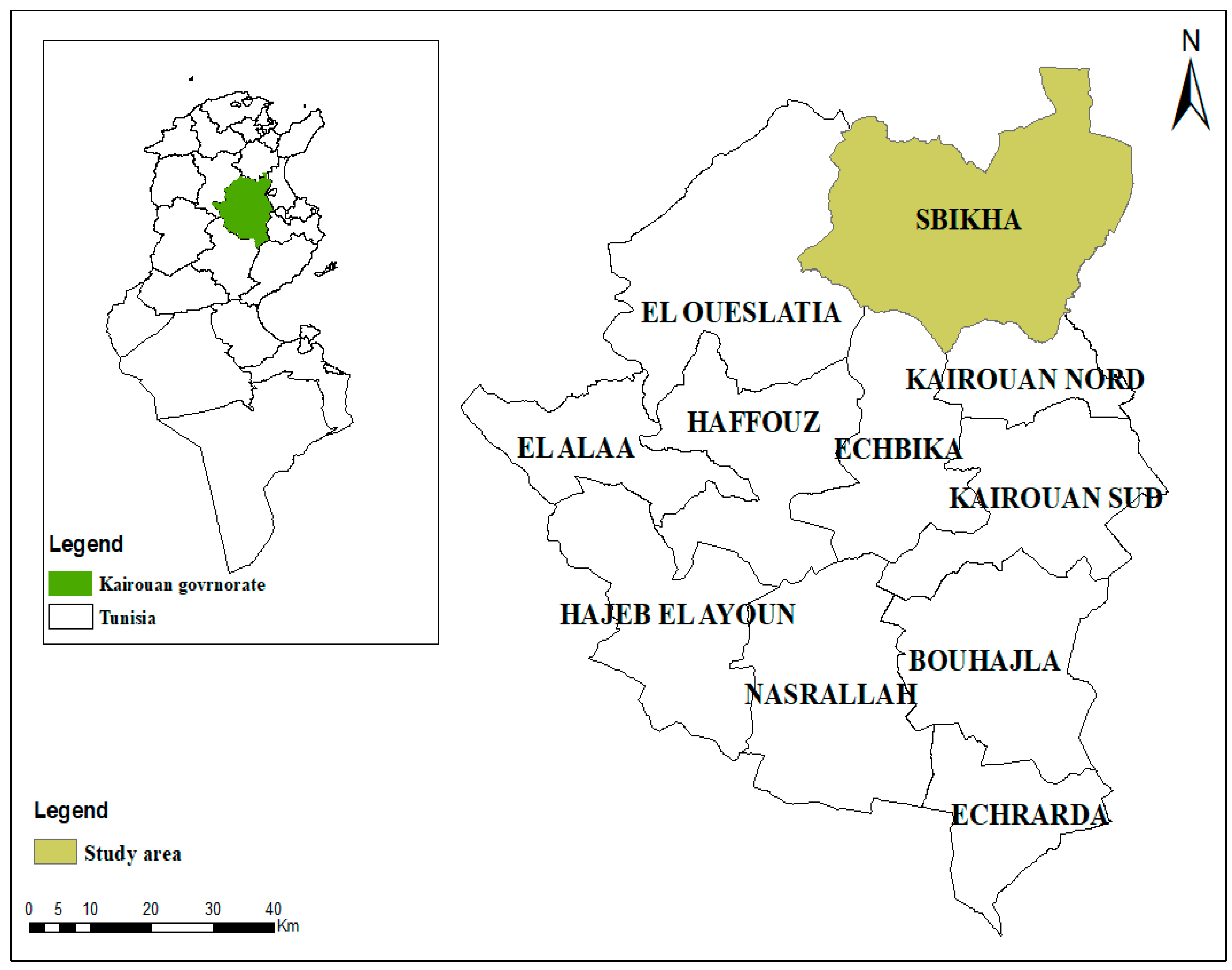

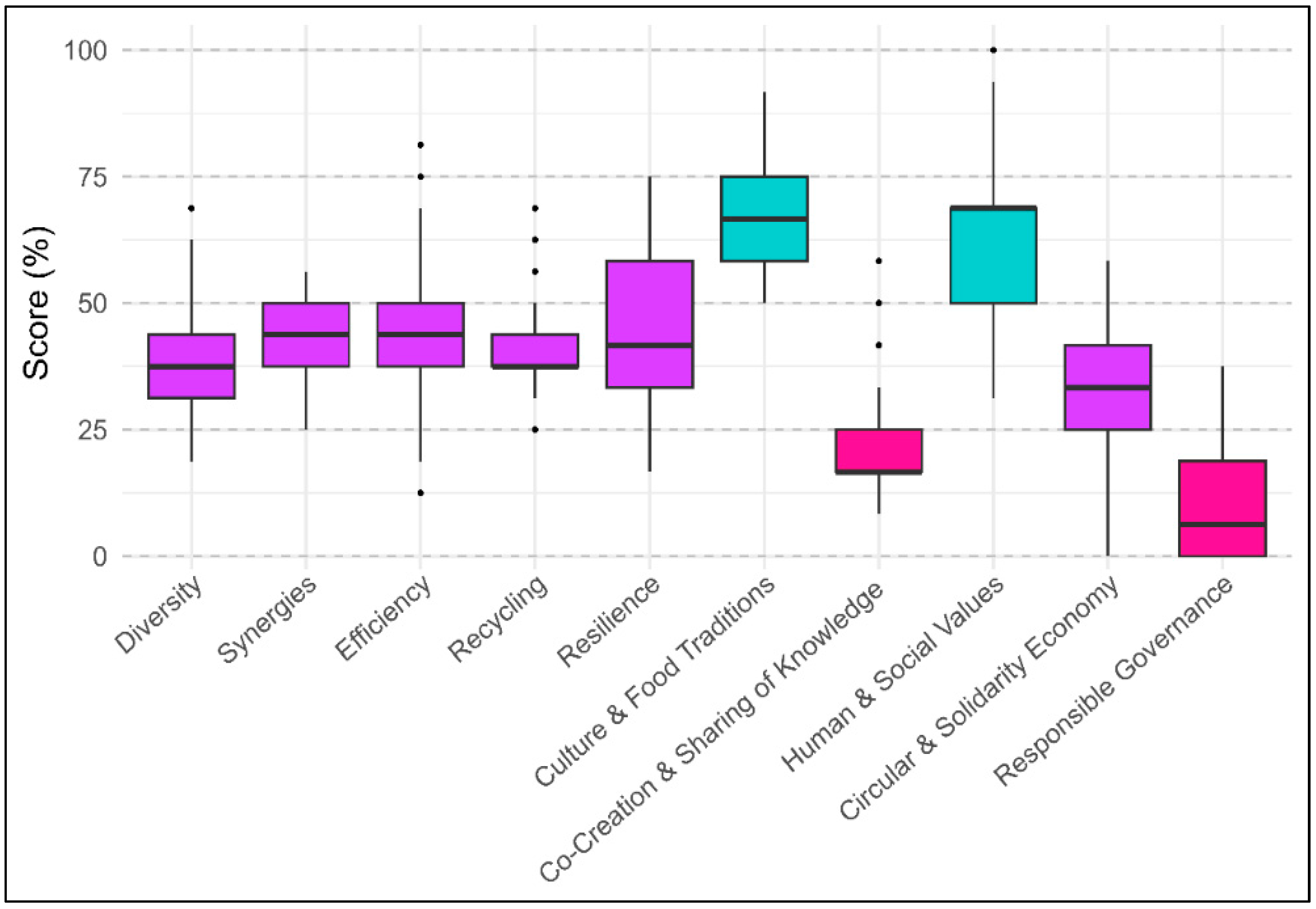
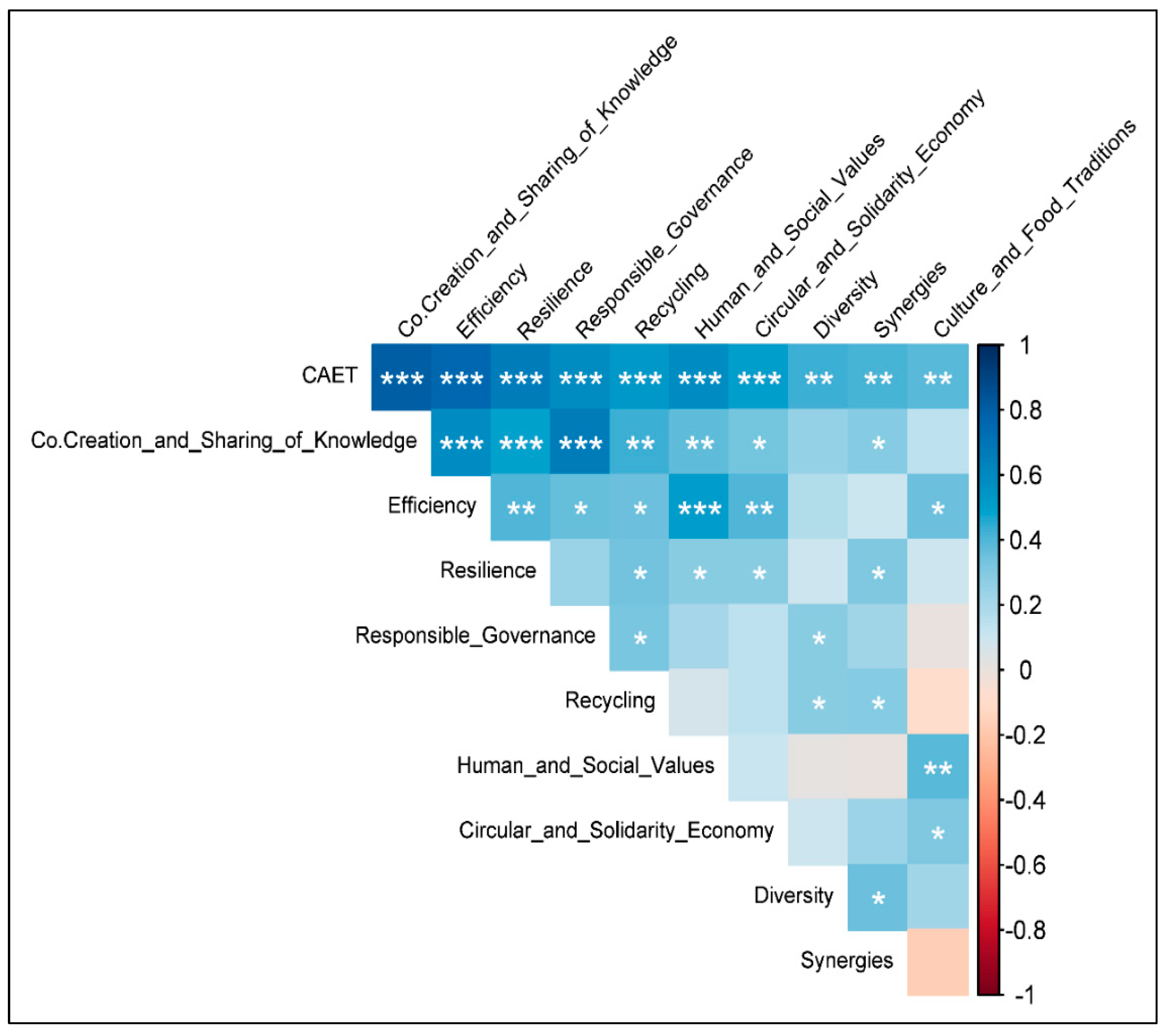

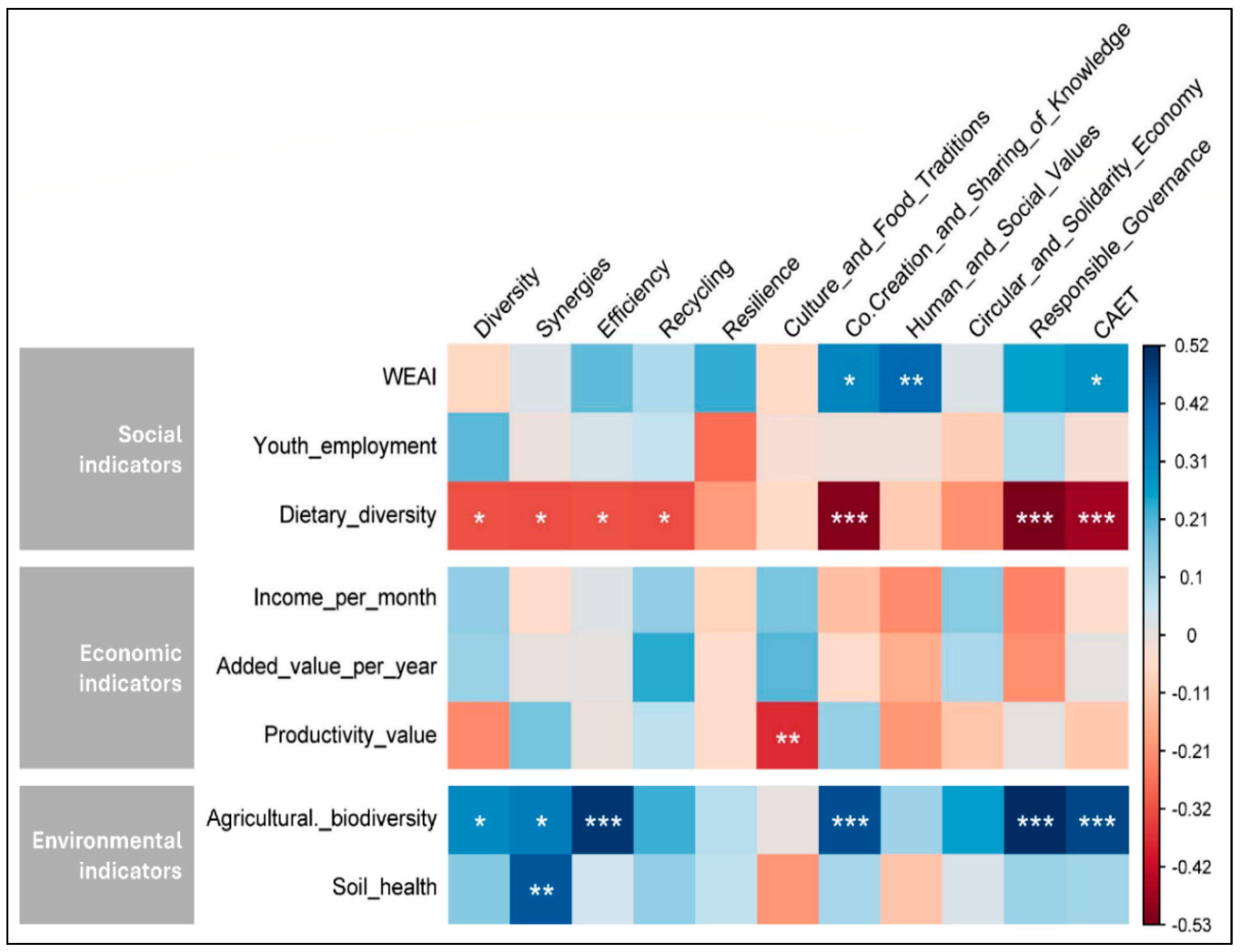
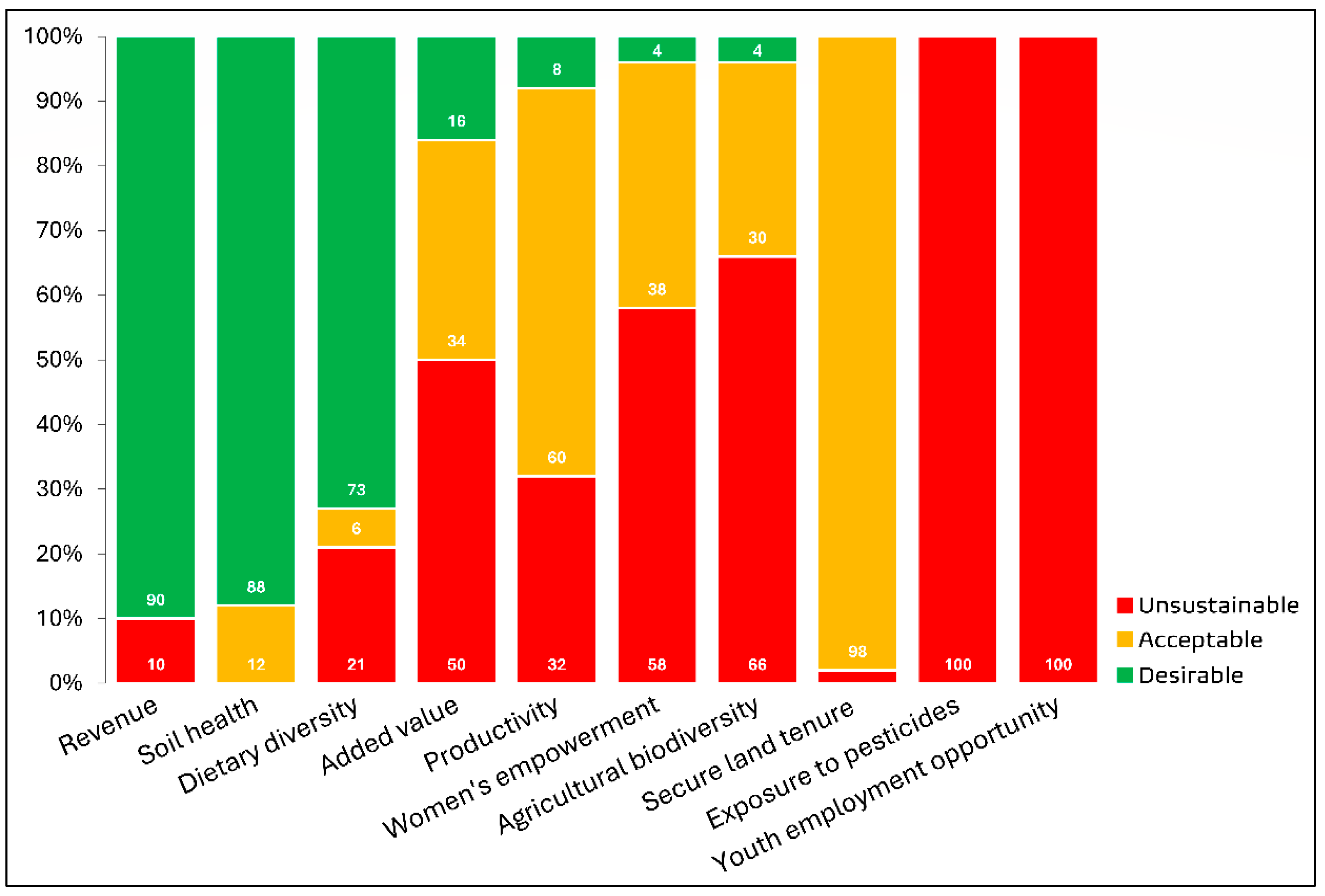
Disclaimer/Publisher’s Note: The statements, opinions and data contained in all publications are solely those of the individual author(s) and contributor(s) and not of MDPI and/or the editor(s). MDPI and/or the editor(s) disclaim responsibility for any injury to people or property resulting from any ideas, methods, instructions or products referred to in the content. |
© 2025 by the authors. Licensee MDPI, Basel, Switzerland. This article is an open access article distributed under the terms and conditions of the Creative Commons Attribution (CC BY) license (https://creativecommons.org/licenses/by/4.0/).
Share and Cite
Gharbi, I.; Aribi, F.; Abdelhafidh, H.; Ferchichi, N.; Lajnef, L.; Toukabri, W.; Jaouad, M. Assessment of the Agroecological Transition of Farms in Central Tunisia Using the TAPE Framework. Resources 2025, 14, 81. https://doi.org/10.3390/resources14050081
Gharbi I, Aribi F, Abdelhafidh H, Ferchichi N, Lajnef L, Toukabri W, Jaouad M. Assessment of the Agroecological Transition of Farms in Central Tunisia Using the TAPE Framework. Resources. 2025; 14(5):81. https://doi.org/10.3390/resources14050081
Chicago/Turabian StyleGharbi, Inès, Fatma Aribi, Hassen Abdelhafidh, Nouha Ferchichi, Lamia Lajnef, Wael Toukabri, and Mohamed Jaouad. 2025. "Assessment of the Agroecological Transition of Farms in Central Tunisia Using the TAPE Framework" Resources 14, no. 5: 81. https://doi.org/10.3390/resources14050081
APA StyleGharbi, I., Aribi, F., Abdelhafidh, H., Ferchichi, N., Lajnef, L., Toukabri, W., & Jaouad, M. (2025). Assessment of the Agroecological Transition of Farms in Central Tunisia Using the TAPE Framework. Resources, 14(5), 81. https://doi.org/10.3390/resources14050081







